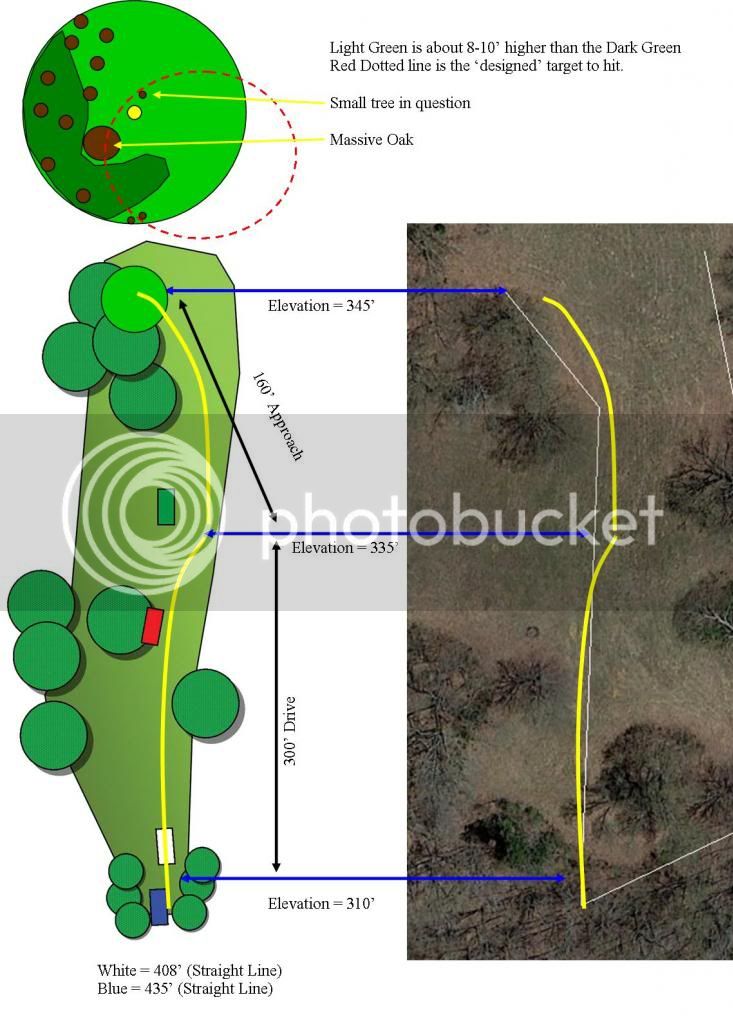No limbs immediately around the basket lower than 8'. If you go back and to the left, there are limbs from other trees about 6-8' high.
Three feet to the right, yes, an easy tap in.
I would think that if the pro was throwing from the ideal spot and aiming for the ideal spot, he should hit it 7 out of ten trys.
The tee shot needs to be a left-to-right shot. Fairway is not a dog-leg, but to have the angle for your approach you want to be far to the right. Anything to the left will easily add a stroke.
If you throw a perfect drive long and to the right - I believe the smart second shot is: right-to-left mid-range (for the skip not distance) Land about 150-160 feet and skip another 10-15 feet from right-to-left. Leaving anywhere from the 3' tap in to a 25' birdie look depending on where you hit.
Brad, thanks again for the very detailed diagrams.
There are a lot of issues to look at here. Let's start with the easiest one.
The first thing I wonder is about the distances. A 300' drive that's 25' uphill seems reasonable. A 160' approach that's 10' uphill is a bit short, but the fact that it's a small green probably makes it OK. If someone throws a shorter drive and has a longer approach, I don't see a problem. The only problem would be for someone who can throw a bigger drive (and I don't see anything that would limit that) -- their approach is probably too easy. But that wasn't really your question.
Is it OK to make players shoot for just part of the green? Absolutely. As I've said recently, I'm doing it using bunkers on the new course in Monroe, Washington, which used to be a ball golf course. Your green basically has the same concept with your 10' dropoff. That seems just fine.
What's different is the trees. What I like about the little tree is that some players who wind up "north" of the basket will have to curve their putt to get around it. It works for that purpose because it's skinny and close to the basket. Of course, being "north" is already tricky because of the dropoff behind the basket.
What I don't like about it is that skinny obstacles create situations that I would consider random or lucky. For example, two players throw almost identical approaches, and one will have to putt around that tree while the other, a foot away, will have a straight look. And worse, the guy who missed farther "west" will also have an open look he probably doesn't deserve.
Even more troubling, two almost identical approaches come in too hot. One goes 30' into the trees on the left; the other hits the skinny tree and drops 2' from the basket.
And some other bad shots will hit the oak and drop 4' from the basket. That oak isn't skinny, but it's going to help a lot of shots that don't deserve help. And some of those other trees will, too. That would probably be my biggest concern with the hole.
All in all, I'd say your concept was good. Maybe there could have been a more elegant way to execute that concept, but it looks like a mostly fun, fair, and challenging hole. So my bottom line is that I'm not going to recommend that you take out the little tree.
The last thing I'd say is that, as a pay-to-play venue, your obligation is to your customer, not to the parks department. So if keeping your customers happy becomes an issue, maybe that tree is worth sacrificing.
Thanks again for the question. Hope that helped a little.

